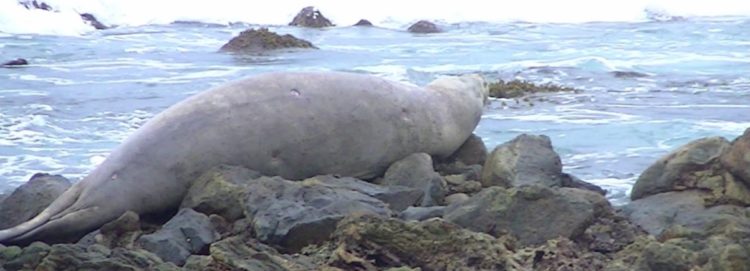COLOMBO, November 2019: Uthpala Adaranga, a ranger with Sri Lanka’s Department of Wildlife Conservation (DWC), was initially doubtful about the call he received of a seal spotted near Unawatuna, off the country’s southern coast on November 20. He assumed, as had happened in the past, that it was another case of misidentification, given that the tropical Indian Ocean island lies well beyond the native range of seals. But to Uthpala’s surprise, it was a seal — a marine mammal never before recorded in Sri Lankan waters.
The seal, about 2 meters (6 feet) long, spent all day on Dalawella Beach, drawing a crowd of onlookers. Wildlife officials together with navy and police personnel had to cordon off the beach to allow some resting space for the animal.
The very next day, the seal disappeared, only to resurface two days later on Nov. 23 near Midigama Beach, about 20 kilometers (12 miles) farther south. This time, it was seen resting on rocks, offering a better view to observers, including of visible signs of old wounds. When a navy team attempted to capture the seal to assess its health, it disappeared again and has not been seen since.
Using amateur video shared on social media, marine biologist Asha de Vos identified the animal as a southern elephant seal (Mirounga leonina), named for its nose that resembles an elephant’s trunk. The largest seal species in the world, the southern elephant seal spends most of its time near Antarctica, only reaching land twice a year to mate and to molt.
De Vos told Mongabay, the world’s most popular rainforest information site and a well-known source of environmental news reporting and analysis, that this individual seal could be from an elephant seal colony from one of the islands off Antarctica, possibly the Kerguelen Islands. That means it would have had to swim about 6,400 kilometers (4,000 miles) to get to Sri Lanka — a feat that’s possible with the aid of ocean currents.
“Seals are active swimmers, but it’s hard to speculate why this individual swam this far north, leaving its native range. The individual found in Sri Lanka looks exhausted and would have reached the beach for some rest,” de Vos said.
Greg Hofmeyr, the curator of marine mammals at Port Elizabeth Museum at Bayworld, South Africa, and a specialist on southern elephant seals, confirmed that southern elephant seals are known for migrating long distances of thousands of kilometers between sub-Antarctic islands and their foraging areas in the Southern Ocean. Many younger animals have an exploratory phase in their life, and the individual spotted in Sri Lanka could be one, he added.
But he said the seal sighting in Sri Lanka, so far away from the species’ native range, was unusual, as seals in general are rarely recorded near the equator.
In 1989, a southern elephant seal was spotted off Oman. It was shot dead for identification purposes. Hofmeyr said there had also been seal sightings in the Mascarene Islands, close to Madagascar, but still about 3,600 kilometers (2,200 miles) south of Sri Lanka.
These seals aren’t considered threatened because they occur in several populations, many of them large, some of them growing, and none of them isolated. But global warming has become the main threat to their existence, manifested in the loss of the pack ice habitats in which they breed, Hofmeyr said.
With the confirmed sighting, the question now for conservationists and officials in Sri Lanka is what to do about the elephant seal. The species is perfectly adapted to the Antarctic cold, and the tropical waters around Sri Lanka would be too harsh for it. There have been calls to capture it and house it in a zoo, although it’s not clear that Sri Lanka has suitable facilities.
“We do not have facilities to accommodate an animal that swims thousands of kilometers and dives thousands of meters in search of food. My advice is to give the animal space, so it can rest and then begin its journey back,” de Vos said.
Claire Simeone, a conservation veterinarian at the California-based Marine Mammal Center, which rescues and rehabilitates seals, said the seal in Sri Lanka could find it difficult to survive in the warmer waters, but that keeping it in captivity would be harder.
“Ideally, the seal’s health should be evaluated by a veterinarian familiar with the particular species,” she told Mongabay. “If the seal is sick or injured, rehabilitation at a zoo or an aquarium could be helpful. But unfortunately, it is challenging to provide the conditions needed for this species in a zoo for its entire life, because they can dive to more than 2,000 meters [6,600 feet] deep. Elephant seals eat squid and deep-water fish and finding this prey might also be one of the challenges to an animal this far from home.”
Simeone suggested the best thing to do would be to give the seal some space. Whether it’s sick, injured, or just resting, the animal will be further stressed by human harassment. “While this seal is indeed quite lost, it is possible that it just needs to rest before going back home,” she added.
She said people should not approach the seal, as it is a wild animal that can bite if it feels threatened. Though it appears exhausted and passive, seals can quickly and turn dangerous if confronted.
Chandana Sooriyabandara, the director-general of the DWC, said there were no plans to capture the seal unless its condition looked particularly bad. “We will let it be our visitor and stay freely in our waters,” he added.




